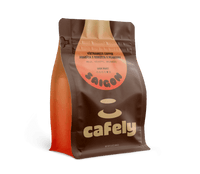Coffee, as we know it, is built on just two pillars: arabica and robusta. Together, they account for 99% of global consumption, with arabica alone making up around 60–70% of production.
Praised for its smooth taste and higher market value, arabica dominates specialty cafes. Robusta, more bitter and often relegated to instant blends, brings resilience to the table.
But what if the future of coffee lies beyond these two familiar species?
Rediscovered & Underutilized Coffee Species
The coffee genus (Coffea) contains over 120 known species, yet the vast majority have been overlooked, forgotten, or abandoned.
As climate change, disease, and biodiversity loss threaten mainstream coffee crops, researchers and growers are turning back to these underutilized, rare coffee beans, many of which hold surprising promise for both sustainability and flavor.
Below, we begin exploring some of these rediscovered heirloom coffee beans that could help reshape the industry’s future.
1. Coffea stenophylla
Once widely cultivated in West Africa, Coffea stenophylla had vanished from farms and nearly disappeared from science altogether — until it was rediscovered in 2018 while growing wild in Sierra Leone.
This heirloom coffee bean has since captured global attention, not only for its fascinating history but for its rare combination of attributes.
- Origin: Sierra Leone, Guinea, and Liberia.
- Highlights: High heat tolerance; drought resilience.
- Taste: Surprisingly complex and arabica-like, with notes of blackcurrant, peach, jasmine, and caramel.
- Significance: Grows in hot-tropical climates at low elevations (400 m), with a mean temperature requirement of 77℉ (25°C), far higher than arabica.
In 2020, a sensory panel in London awarded it a Specialty Coffee Association score of 80.25, confirming its value as a premium, climate-resilient alternative.
With wild populations classified as Vulnerable by the IUCN, efforts are now underway to plant stenophylla in controlled environments to assess its long-term cultivation potential.
For coffee growers facing rising temperatures, stenophylla could be a game-changer among rare coffee beans.
2. Coffea affinis
Closely related to stenophylla, Coffea affinis (also known historically as “Kamaya coffee”) has remained in the shadows, largely due to its tangled taxonomy and rarity in cultivation.
First reported in 1900 from a research garden in Guinea, it was once viewed as a highly vigorous and disease-resistant plant.
- Origin: Guinea and Ivory Coast.
- Highlights: Large leaves; strong vegetative growth.
- Taste: High-quality potential, though under-studied.
- Significance: Closely mirrors stenophylla in fruit form but differs in foliage and structure.
Despite debate over whether it’s a distinct species, a hybrid, or a varietal offshoot, affinis has clear genetic and agronomic value.
Its potential for disease resistance and crop diversity makes it an important candidate for future breeding programs, particularly as climate shifts challenge conventional species.
3. Coffea liberica

Discovered in Sierra Leone in 1872, Coffea liberica once held promise for liberica's role as a potential third major crop in the global coffee industry.
However, it faded into obscurity, partly due to its large bean size, peculiar shape, and strong, unconventional flavor, which was often misunderstood and misclassified.
- Origin: Central and West Africa.
- Highlights: Massive beans; high sugar content; exceptional pest resistance.
- Taste: Intensely aromatic and complex — notes may include floral, smoky, or fermented layers.
- Significance: Naturally resilient to pests like the broca beetle; grows in hot, humid climates.
Today, liberica accounts for less than 1% of the global market, but momentum is slowly building.
Countries like Malaysia and the Philippines are beginning to revive this heirloom coffee bean, particularly as consumers and producers seek out bold, terroir-driven flavor profiles.
For those who prize rare coffee beans with distinct character, liberica offers a sensory journey far beyond the ordinary cup.
4. Coffea eugenioides
Arabica may be the reigning champion of specialty coffee, but it owes its very existence to a quiet, lesser-known parent: Coffea eugenioides.
Alongside canephora (robusta), this East African species gave rise to arabica in the highlands of Ethiopia thousands of years ago. Today, eugenioides is finally emerging from its parents’ shadow.
- Origin: East Africa.
- Highlights: Naturally low caffeine; delicate floral and sweet notes.
- Taste: Described as smooth, mellow, and unusual, with tasting notes like marshmallow, lemon drop, sesame snap, and cereal milk.
- Significance: Offers unique genetic material for low-caffeine coffee breeding.
Recently brought back into focus by World Barista Championship competitors, eugenioides has stunned judges with its clarity and softness.
Though it remains exceptionally rare and difficult to cultivate at scale, this species opens exciting doors for specialty markets and health-conscious consumers alike.
5. Coffea racemosa
Native to the sandy coastal forests of southern Mozambique and eastern South Africa, Coffea racemosa is one of the most drought-tolerant coffee species on record.
Unlike most cultivated varieties, it thrives in arid, nutrient-poor soil — a quality that’s becoming more attractive as global temperatures climb.
- Origin: Mozambique, South Africa.
- Notable Traits: Thrives in semi-arid zones; resistant to common diseases.
- Taste: Delicate body, floral aroma, mild acidity, and a soft herbal finish.
- Significance: Contains about half of the caffeine of arabica (0.38–0.65%).
Though rarely grown commercially, a small group of producers in Mozambique has been working to reintroduce racemosa to the global market.
As a rare coffee bean, it not only supports local economies but also shows that quality can come from unexpected environments, even the desert.
6. Coffea excelsa (C. liberica var. dewevrei)
Once considered its own species, excelsa was reclassified in 2006 as a variety of C. liberica, but many in the industry still treat it as a distinct entity. It produces tall, robust trees with deeply lobed leaves and beans that are both drought- and heat-tolerant.
- Origin: Central Africa.
- Notable Traits: Resilient, high-yielding, highly adaptable.
- Taste: Bold, tart, fruity, often likened to dark berries or tamarind.
- Significance: Provides body and punch in blends; resilient to pests and erratic climate.
Though still hard to find, excelsa is gaining cult status among experimental roasters. Its complex flavor and rare profile are helping push the boundaries of what specialty coffee can taste like.
7. Coffea charrieriana
Discovered in Cameroon in 2008, Coffea charrieriana is the first naturally caffeine-free coffee species from Africa.
While decaf coffee typically relies on chemical or CO₂-based extraction methods, charrieriana produces beans that are caffeine-free by nature.
- Origin: Cameroon.
- Notable Traits: No caffeine; rare flowering pattern.
- Taste: Still being researched, but expected to be mild and floral.
- Significance: A possible game-changer for naturally decaffeinated breeding.
Although commercial cultivation is still in early research stages, charrieriana has enormous promise for health-conscious markets.
If bred successfully with arabica or other desirable species, it could produce rare coffee beans that deliver flavor without the stimulant — an innovation consumers have been waiting for.
8. Coffea pseudozanguebariae
A lesser-known cousin in the coffee family, Coffea pseudozanguebariae, is found in lowland regions of East Africa.
Though almost entirely overlooked by mainstream coffee market, it contains some rare traits that breeders are paying attention to, especially its extremely low caffeine content.
- Origin: Kenya, Tanzania, Mozambique.
- Notable Traits: Very low caffeine; small plant size; flowers twice per year.
- Taste: Data is limited, but described as subtle and clean.
- Significance: A genetic reservoir for low-caffeine breeding.
Its habit of flowering more than once per year is particularly rare in coffee and could be a useful trait for improving yields in other species.
While not likely to become a staple roast on its own, C. pseudozanguebariae could play a supporting role in breeding the next generation of climate-smart, specialty heirloom coffee beans.
The Importance of Coffee Biodiversity
Coffee biodiversity is more than a catalog of obscure plants — it’s the genetic safety net for an industry facing serious threats. The diversity found in wild and heirloom coffee beans holds the key to long-term resilience, adaptability, and flavor innovation.
Genetic Goldmines: The Role of Wild Coffee Species
Every wild coffee species contains a unique combination of traits shaped by its native environment — traits that cultivated arabica and robusta may lack.
These include:
- Drought and heat tolerance: Species like Coffea racemosa survive in dry, nutrient-poor soil.
- Pest and disease resistance: Some wild types exhibit natural resilience to leaf rust and fungal pathogens.
- Unique flavor profiles: Coffea eugenioides, for example, is prized for its floral, tea-like notes and lower bitterness.
- Naturally low or zero caffeine: Coffea charrieriana offers a naturally caffeine-free option, without chemical decaffeination.
Genetic advantages make wild and lesser-known species invaluable as breeding stock — and as direct sources of new, distinctive coffees. The coffee of tomorrow may well come from a gene pool we’re only just beginning to understand, as shown by evolving global coffee production trends.
Climate Change: A Brewing Crisis
Decades of research — particularly by the Royal Botanic Gardens (Kew), England — has painted a troubling picture. In 2019, Kew scientists published the first-ever Red List assessment for all 124 known coffee species. The findings?
- 60% of wild coffee species are at risk of extinction.
- Arabica itself is now classified as Endangered under IUCN criteria.
- Climate models project that suitable growing areas for wild arabica in Ethiopia could shrink by up to 85% by 2080.
- Up to 60% of Ethiopia’s existing coffee farmland may become unsuitable by the century’s end.
Extreme weather events, shifting rainfall, and increasing pest pressure are already pushing coffee farmers to their limits.
Solutions like relocating farms or changing farming practices are often prohibitively expensive, especially for smallholder producers.
The long-term answer lies in diversification — in leveraging the strengths of rare coffee beans adapted to challenging conditions.
Conservation & Research Efforts

Protecting these rare beans takes work on multiple fronts. Scientists, institutions, and growers are all playing a role — from preserving wild species in forests to maintaining seed collections and launching global research collaborations.
In Situ Conservation: Protecting Coffee in the Wild
“In situ” conservation means preserving species where they naturally grow — in forests, hillsides, and biodiverse ecosystems. This approach is critical for coffee.
Wild species evolve in highly specific environments; removing them from these habitats may destroy not only the plant but its complex ecological relationships (such as with pollinators, microbes, or shade trees).
But many of these native habitats — especially in Madagascar, Cameroon, Ethiopia, and Central Africa — are under constant threat from deforestation and agricultural encroachment. Without protection, the forests that shelter heirloom coffee beans could vanish before we’ve even fully cataloged them.
Ex Situ Conservation: A Scientific Safety Net
To back up in situ efforts, researchers also use “ex situ” strategies — storing living seeds or plants in controlled environments.
These environments include:
- Germplasm banks: Institutions like CATIE in Costa Rica and the USDA maintain living collections of coffee varieties, often used in breeding programs.
- Botanical gardens: Places like Kew Gardens in the United Kingdom act as living libraries for rare coffee beans, housing specimens that may one day serve as genetic lifelines.
- Cryopreservation and seed vaults: Some programs even freeze coffee seeds or tissues for long-term storage, though coffee seeds are notoriously difficult to preserve this way.
These collections are essential for research and restoration. If a wild coffee population is lost in the field, ex-situ repositories may be the only way to bring it back.
Research Initiatives: Who’s Leading the Charge?
While much of the global coffee economy is focused on yield and taste, a few organizations have taken up the fight for biodiversity.
At the forefront is the Royal Botanic Gardens, Kew, which has led more than 20 years of dedicated coffee research across Africa and Madagascar.
Some of their work includes the following:
- Mapped the distribution of all 124 known species.
- Assessed extinction risk using IUCN Red List standards.
- Identified climate-resilient species like Coffea stenophylla and Coffea racemosa.
- Promoted cultivation of underutilized species for both conservation and market use.
Other efforts include:
- World Coffee Research, which works on breeding climate-resilient hybrids.
- The Crop Trust, supports the long-term conservation of genetic resources for food security.
- National research stations in producing countries like Ethiopia, Uganda, and Madagascar.
Together, these groups are working to shift the industry away from monoculture and toward a more biodiverse, sustainable, and flavour-rich future driven by heirloom coffee beans.
Challenges in Reviving Forgotten Coffee Varieties
Reviving heirloom and rare coffee beans is a noble effort, but it’s not without complications. The road back for these forgotten varieties is marked by agronomic, economic, and market-related hurdles.
Agronomic Limitations
Most heirloom coffee beans weren’t bred for high-yield or commercial resilience. Compared to modern hybrids, they may struggle with pests, fluctuating climates, or lower output per tree. This makes them less appealing for farmers who depend on volume to stay financially viable.
Even those that boast remarkable taste or disease resistance may require new farming techniques or microclimate adjustments to thrive. Until better agronomic data and region-specific support systems are in place, cultivating these varieties can feel risky.
Market Acceptance
Many consumers have never heard of rare coffee beans like Coffea stenophylla or wild arabica strains. Specialty buyers may chase unique flavors, but the broader market still favors consistency and familiarity.
To make room for these forgotten beans, roasters, cafés, and retailers must educate consumers about their origins, taste profiles, and ecological value.
Flavor alone might spark curiosity, but building long-term demand requires storytelling, transparency, and trust in the product’s sustainability and impact.
Economic Factors
Reviving heirloom varieties takes investment, both financial and temporal. Research programs, seed propagation, experimental plots, and farmer training all come with costs.
In regions where farmers already operate on tight margins, the opportunity cost of switching crops or experimenting with lower-yielding varieties is significant.
Without institutional support or market incentives, many farmers cannot afford to grow what may be the most culturally and ecologically valuable beans in the world.
Future Prospects
Despite the challenges, the momentum behind rediscovering forgotten coffee beans is building. Scientific research, specialty market trends, and policy shifts are aligning in ways that offer new hope.
Breeding Programs
By incorporating traits from wild and heirloom coffee beans into commercial lines, breeding programs can improve resilience without sacrificing flavor.
For instance, wild arabica relatives may carry natural resistance to coffee leaf rust or greater heat tolerance. These genes are now being studied to strengthen mainstream crops.
Such initiatives help bridge the gap between conservation and cultivation, making rare beans more viable at scale.
Specialty Coffee Market
The specialty coffee scene is a natural ally in this movement. It thrives on exclusivity, terroir, and complexity — qualities heirloom varieties deliver in abundance.
Coffees like Eugenioides or Geisha fetch premium prices due to their rarity and unique flavor profiles. As roasters and consumers seek out new experiences, the market opens up for underappreciated beans that might otherwise disappear.
This growing demand could incentivize more farmers to reintroduce heirloom strains, especially when supported by traceability and storytelling.
Policy & Support
None of this happens without systemic backing. Government programs and international bodies must step in to fund conservation, support research, and protect farming livelihoods.
Institutions like the Royal Botanic Gardens, Kew, are already playing a vital role, not just by studying extinction risks, but by advocating for practical conservation methods, such as assisted migration and habitat restoration.
Ethiopia, as the birthplace of wild arabica, stands to benefit greatly from policy efforts aimed at forest regeneration and climate adaptation.
A Brew Worth Preserving: Why Heirloom Coffee Deserves a Comeback

In a world dominated by convenience and uniformity, heirloom and rare coffee beans remind us of what makes coffee truly special: diversity, resilience, and culture.
These forgotten varieties carry not just flavor, but stories, traditions, and vital genetics that could help safeguard the future of coffee.
Reviving them is no small task. It requires dedicated farmers, scientific investment, and consumers willing to try something new.
The future of coffee may very well depend on the past we choose to preserve today.
FAQs: Forgotten Coffee Varieties
Let’s review some common questions about forgotten coffee varieties:
1. What are Forgotten Coffee Varieties?
Forgotten coffee varieties refer to rare or underutilized coffee species that have fallen out of mainstream production. These beans often possess unique traits such as distinct flavor profiles, climate tolerance, or disease resistance, making them valuable for the future of coffee cultivation.
2. Why are They Important?
They provide vital genetic diversity, which can help coffee crops adapt to changing climates, resist pests and diseases, and survive environmental pressures. This diversity supports long-term sustainability and flavor innovation across the industry.
3. Can These Varieties Replace Arabica & Robusta?
Not entirely. While they may not replace arabica or robusta at scale, they can complement them in breeding programs and specialty markets. Their traits can also be used to enhance existing cultivars through hybridization.
4. Are These Coffees Available Commercially?
Some heirloom and rare coffee beans, like liberica or excelsa, are available through specialty roasters or regional markets. Others are still in trial phases or limited to conservation and research institutions.
5. Do the Coffee Varieties Taste Different?
Yes — many heirloom coffee varieties offer unusual and complex flavors, ranging from floral and tea-like to bold, fruity, or spiced notes. Their profiles often differ significantly from conventional arabica or robusta.
6. Are They More Sustainable?
In many cases, yes. Several of these forgotten varieties are naturally more resilient to drought, heat, and pests, reducing the need for pesticides or intensive care. This makes them strong candidates for sustainable coffee production.
7. Where are These Varieties Grown?
They’re primarily native to regions in Africa, such as Ethiopia and Madagascar, and parts of Southeast Asia. Many grow in wild or semi-wild forests, while some are cultivated in smallholder plots or experimental farms.
8. What Challenges Exist In Cultivating Them?
Challenges include lower yield potential, limited agronomic research, lack of farmer familiarity, and weak commercial demand. Additionally, processing methods and infrastructure often need adaptation to support these beans.
9. How Can Consumers Support These Varieties?
By purchasing coffees made from rare or heirloom beans when available, supporting roasters who prioritize biodiversity, and raising awareness about the value of coffee conservation. Every cup becomes a vote for diversity.
10. What Is the Future of Forgotten Coffee Varieties?
With increasing interest from researchers, specialty roasters, and sustainability advocates, these varieties are gaining attention. Their resilience and flavor potential make them key players in the future of a more diverse and secure coffee industry.












